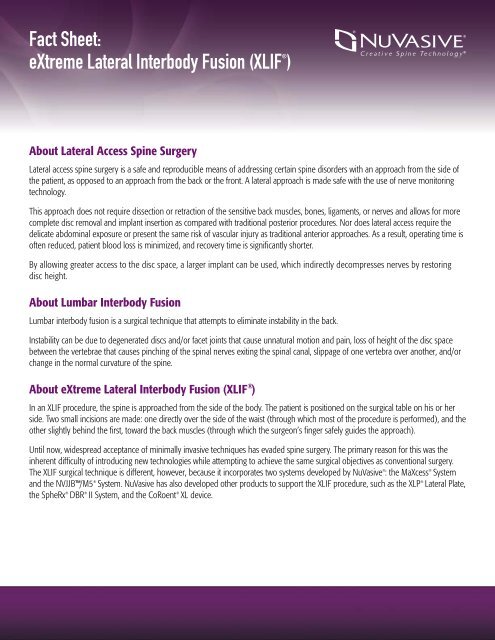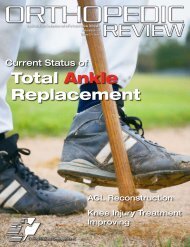Fact Sheet: eXtreme Lateral Interbody Fusion (XLIF®)
Fact Sheet: eXtreme Lateral Interbody Fusion (XLIF®)
Fact Sheet: eXtreme Lateral Interbody Fusion (XLIF®)
You also want an ePaper? Increase the reach of your titles
YUMPU automatically turns print PDFs into web optimized ePapers that Google loves.
<strong>Fact</strong> <strong>Sheet</strong>:<br />
<strong>eXtreme</strong> <strong>Lateral</strong> <strong>Interbody</strong> <strong>Fusion</strong> (XLIF ® )<br />
About <strong>Lateral</strong> Access Spine Surgery<br />
<strong>Lateral</strong> access spine surgery is a safe and reproducible means of addressing certain spine disorders with an approach from the side of<br />
the patient, as opposed to an approach from the back or the front. A lateral approach is made safe with the use of nerve monitoring<br />
technology.<br />
This approach does not require dissection or retraction of the sensitive back muscles, bones, ligaments, or nerves and allows for more<br />
complete disc removal and implant insertion as compared with traditional posterior procedures. Nor does lateral access require the<br />
delicate abdominal exposure or present the same risk of vascular injury as traditional anterior approaches. As a result, operating time is<br />
often reduced, patient blood loss is minimized, and recovery time is significantly shorter.<br />
By allowing greater access to the disc space, a larger implant can be used, which indirectly decompresses nerves by restoring<br />
disc height.<br />
About Lumbar <strong>Interbody</strong> <strong>Fusion</strong><br />
Lumbar interbody fusion is a surgical technique that attempts to eliminate instability in the back.<br />
Instability can be due to degenerated discs and/or facet joints that cause unnatural motion and pain, loss of height of the disc space<br />
between the vertebrae that causes pinching of the spinal nerves exiting the spinal canal, slippage of one vertebra over another, and/or<br />
change in the normal curvature of the spine.<br />
About <strong>eXtreme</strong> <strong>Lateral</strong> <strong>Interbody</strong> <strong>Fusion</strong> (XLIF ® )<br />
In an XLIF procedure, the spine is approached from the side of the body. The patient is positioned on the surgical table on his or her<br />
side. Two small incisions are made: one directly over the side of the waist (through which most of the procedure is performed), and the<br />
other slightly behind the first, toward the back muscles (through which the surgeon’s finger safely guides the approach).<br />
Until now, widespread acceptance of minimally invasive techniques has evaded spine surgery. The primary reason for this was the<br />
inherent difficulty of introducing new technologies while attempting to achieve the same surgical objectives as conventional surgery.<br />
The XLIF surgical technique is different, however, because it incorporates two systems developed by NuVasive ® : the MaXcess ® System<br />
and the NVJJB TM /M5 ® System. NuVasive has also developed other products to support the XLIF procedure, such as the XLP ® <strong>Lateral</strong> Plate,<br />
the SpheRx ® DBR ® II System, and the CoRoent ® XL device.
<strong>Fact</strong> <strong>Sheet</strong>:<br />
<strong>eXtreme</strong> <strong>Lateral</strong> <strong>Interbody</strong> <strong>Fusion</strong> (XLIF ® )<br />
XLIF ® Patient Benefits<br />
Reduced operative time – Traditional procedures can take many hours to perform, the while XLIF procedure can be successfully<br />
completed in as little as one hour, reducing the amount of anesthesia time.<br />
Reduced blood loss and minimal scarring – The MaXcess ® retractor dilates the tissue rather than cutting, resulting in much less<br />
trauma to the affected area.<br />
Reduced postoperative pain – The XLIF procedure does not require entry through sensitive back muscles, bones, or ligaments, so<br />
patients are usually walking the same day.<br />
Reduced hospital stay – XLIF requires only an overnight stay in the hospital, compared to several days of immobility and<br />
hospitalization typical of traditional open approaches.<br />
Rapid return to normal activity – Patients are usually walking the same day after surgery and recovery is typically around 6 weeks,<br />
compared to 6 months or more.
<strong>Fact</strong> <strong>Sheet</strong>:<br />
<strong>eXtreme</strong> <strong>Lateral</strong> <strong>Interbody</strong> <strong>Fusion</strong> (XLIF ® )<br />
XLIF ® Clinical Applications<br />
The XLIF minimally disruptive procedure can be performed for a number of situations. The list below contains representative examples.<br />
The list is not intended to include all possible indications/and or contraindications.<br />
Any thoracolumbar case above L5-S1 requiring access to the disc space and/or vertebral bodies. Examples include:<br />
• DDD with Instability<br />
• Recurrent Disc Herniation<br />
• Degenerative Spondylolisthesis ( ≤ grade 2)<br />
• Degenerative Scoliosis<br />
• Pseudarthrosis<br />
• Discitis, Vertebral Osteomyelitis (without active infection)<br />
• TDR Revision<br />
• Post-Laminectomy Instability<br />
• Junctional Disease<br />
XLIF May Not Be Right for You if Any of the Following Apply to You:<br />
Any generally accepted contraindication to fusion, such as:<br />
• Systemic infection<br />
• Osteoporosis<br />
• Significant co-morbidities<br />
• L5-S1<br />
• Lumbar deformities with > 30° rotation<br />
• Degenerative spondylolisthesis grade 3<br />
• Bilateral retroperitoneal scarring (e.g., abscess or prior surgery)<br />
• Need for direct posterior decompression through same approach (Second posterior micro-decompression not contraindicated)
<strong>Fact</strong> <strong>Sheet</strong>:<br />
<strong>eXtreme</strong> <strong>Lateral</strong> <strong>Interbody</strong> <strong>Fusion</strong> (XLIF ® )<br />
Side Effects:<br />
• Revision or reoperation;<br />
• Change in lordosis;<br />
• Injuries to kidneys or ureters;<br />
• Deterioration in neurological status;<br />
• Facet joint deterioration;<br />
• Spondylolysis;<br />
• Spondylosis;<br />
• Spondylolisthesis;<br />
• Nerve damage due to surgical trauma, neurological difficulties including bowel and/bladder dysfunction, retrograde ejaculation,<br />
tethering of nerves in scar tissue, muscle weakness or paresthesia;<br />
• Vascular damage including hematoma, ileus injuries, deep vein thrombosis potentially leading to pulmonary embolism,<br />
catastrophic or fatal bleeding;<br />
• Dural tears experienced during surgery resulting in the need for further surgery for dural repair, a chronic CSF leak or fistula, and<br />
possible meningitis;<br />
• Bursitis;<br />
• Paralysis;<br />
• Damage to lymphatic vessels and/or lymphatic fluid exudation;<br />
• Fracture of bony structures;<br />
• Anesthetic reaction;<br />
• Bowel perforation;<br />
• Hernia;<br />
• Infection -- Peritonitis;<br />
• Periotoneal adhesions;<br />
• Failure of the procedure to improve symptoms and/or functions;<br />
• Spinal stenosis;<br />
• Death
<strong>Fact</strong> <strong>Sheet</strong>:<br />
<strong>eXtreme</strong> <strong>Lateral</strong> <strong>Interbody</strong> <strong>Fusion</strong> (XLIF ® )<br />
MaXcess ® System<br />
The MaXcess System provides customized maximum surgical access while minimizing the soft tissue disruption that often occurs during<br />
open surgery. As opposed to minimal access systems, which provide minimal spinal access, minimal visualization, and minimal surgical<br />
confidence, the MaXcess System from NuVasive ® offers improved visualization, and increased angulation and positioning of instruments<br />
and implants.<br />
This provides the surgeon all the benefits of a minimally disruptive surgical<br />
approach without compromising conventional surgical techniques.<br />
The MaXcess System allows the fundamentals of conventional surgical<br />
techniques to be achieved, while eliminating the unfamiliar requirements of<br />
operating coaxially through tubular portals. Additionally, since there are no<br />
adjunctive visualization tools (e.g., endoscope, monitor), the MaXcess System<br />
enables direct illuminated visualization of the patient’s anatomy through<br />
conventional methods.<br />
NVM5 TM<br />
The NVM5 System is a technologically advanced intraoperative nerve monitoring system that assists the surgeon with safe implant<br />
placement and surgical technique by monitoring the patient’s nerve activity throughout the surgical procedure.<br />
Electromyography (EMG), the study of the electrical activity of muscles, is used during the XLIF ® procedure to determine the health and<br />
function of nerves, particularly in cervical or lumbar spine surgeries where nerve roots are affected.<br />
The NVM5 System combines intraoperative electrically stimulated EMG and spontaneous EMG activity to assess possible nerve root<br />
irritation or injury during surgery. Software algorithms help provide the surgeon with<br />
real-time data to assist with patient nerve safety.<br />
Monitoring the muscles requires the placement of adhesive needle electrodes on or<br />
under the skin overlying the patient’s leg muscles. These electrodes record muscle<br />
activity during the procedure, providing information about the health and function of<br />
the specific spinal nerves that indicate muscle activity and sensation functions to them.<br />
The NVM5 System’s automated features allow it to seamlessly integrate into the<br />
surgical technique while providing accurate and reproducible real-time feedback about nerve health and function. The system allows<br />
the surgeon to have first-hand knowledge of the monitoring results, confirming the safe progression of the XLIF surgical procedure.
<strong>Fact</strong> <strong>Sheet</strong>:<br />
<strong>eXtreme</strong> <strong>Lateral</strong> <strong>Interbody</strong> <strong>Fusion</strong> (XLIF ® )<br />
XLP ® <strong>Lateral</strong> Plate<br />
The objective in developing the XLP lateral plate was to provide a simple yet reliable<br />
method of internal fixation delivered through a single XLIF approach. XLP lateral plate<br />
fixation allows a surgeon to preserve the minimally invasive benefits of a standalone<br />
XLIF procedure while providing effective stabilization to the interbody implant.<br />
Through clinical evaluation and system refinement, NuVasive has designed each<br />
component of the XLP platform to work seamlessly with the MaXcess ® retractor and<br />
the XLIF approach, resulting in an efficient system.<br />
XLP fixation adds only a few minutes to the XLIF procedure, but saves valuable<br />
operating room time by eliminating the need to reposition the patient prior to<br />
instrumentation.<br />
The XLP lateral plate is a significant advancement in the evolution of the XLIF approach<br />
that provides measurable benefits to the patient, hospital, and surgeon. This singleapproach<br />
procedure provides a number of benefits, including:<br />
• A safe, reproducible approach<br />
• Decreased operative time<br />
• Shortened hospital stay<br />
• Quicker patient recovery and return to normal activity<br />
SpheRx ® DBR ® II System<br />
The SpheRx DBR II Minimally Disruptive Fixation System offers a solution for<br />
performing effective minimally disruptive spinal fixation in a simple, straightforward<br />
manner. Seamless, step-by-step integration of NVJJB TM /M5 ® nerve monitoring<br />
provides real-time feedback throughout the surgery and helps to ensure safe<br />
hardware placement and neural integrity. Additionally, the spherical end of the<br />
SpheRx DBR II rod fits precisely into the screw head, leaving no residual rod<br />
overhang at the superior end of the construct. This reduced implant profile may<br />
minimize the incidence of hardware-related, adjacent level symptoms.
<strong>Fact</strong> <strong>Sheet</strong>:<br />
<strong>eXtreme</strong> <strong>Lateral</strong> <strong>Interbody</strong> <strong>Fusion</strong> (XLIF ® )<br />
CoRoent ® XL<br />
CoRoent XL is an anterior column reconstruction device sized for stability, anatomically<br />
shaped, and designed for simplicity. Its large, anatomical shape provides maximum surface<br />
area and structural stability, and its large apertures allow bony through-growth. CoRoent<br />
XL’s radiolucent PEEK-OPTIMA ® material provides optimal stiffness compatibility with<br />
the surrounding bone, and its titanium markers enable easy-to-interpret placement and<br />
orientation verification.<br />
CoRoent XL has multiple length options to ensure optimal apophyseal support, reducing the<br />
chance of subsidence. Additionally, it’s available in lordotic profiles to induce proper sagittal<br />
alignment.<br />
It is important that you discuss the potential risks, complications, and benefits of the XLIF<br />
procedure with your doctor prior to receiving treatment and that you rely on your physician’s<br />
judgment. Only your doctor can determine whether you are a suitable candidate for this treatment.<br />
About NuVasive ®<br />
NuVasive is a medical device company focused on the design, development, and marketing of products for the surgical treatment<br />
of spine disorders. The Company’s product portfolio is focused on applications in the over $4.2 billion U.S. spine fusion market. The<br />
Company’s current principal product offering includes a minimally disruptive surgical platform called Maximum Access Surgery, or<br />
MAS ® , as well as a growing offering of cervical and motion preservation products.<br />
Contact Information<br />
MarketingCommunications@nuvasive.com<br />
NuVasive, Inc. • 7475 Lusk Blvd., San Diego, CA 92121 • phone: 800-475-9131 • fax: 800-475-9134<br />
www.nuvasive.com | www.xlif.com | www.lateralaccess.org<br />
10-NUVA-200<br />
©2011. NuVasive, Inc. All rights reserved. , NuVasive, Creative Spine Technology, CoRoent, DBR, M5, MAS, MaXcess,<br />
SOLAS, SpheRx, XLIF, and XLP are federally registered trademarks of NuVasive, Inc. NVJJB and NVM5 is a common law trademark of NuVasive, Inc. Patent(s) pending.




